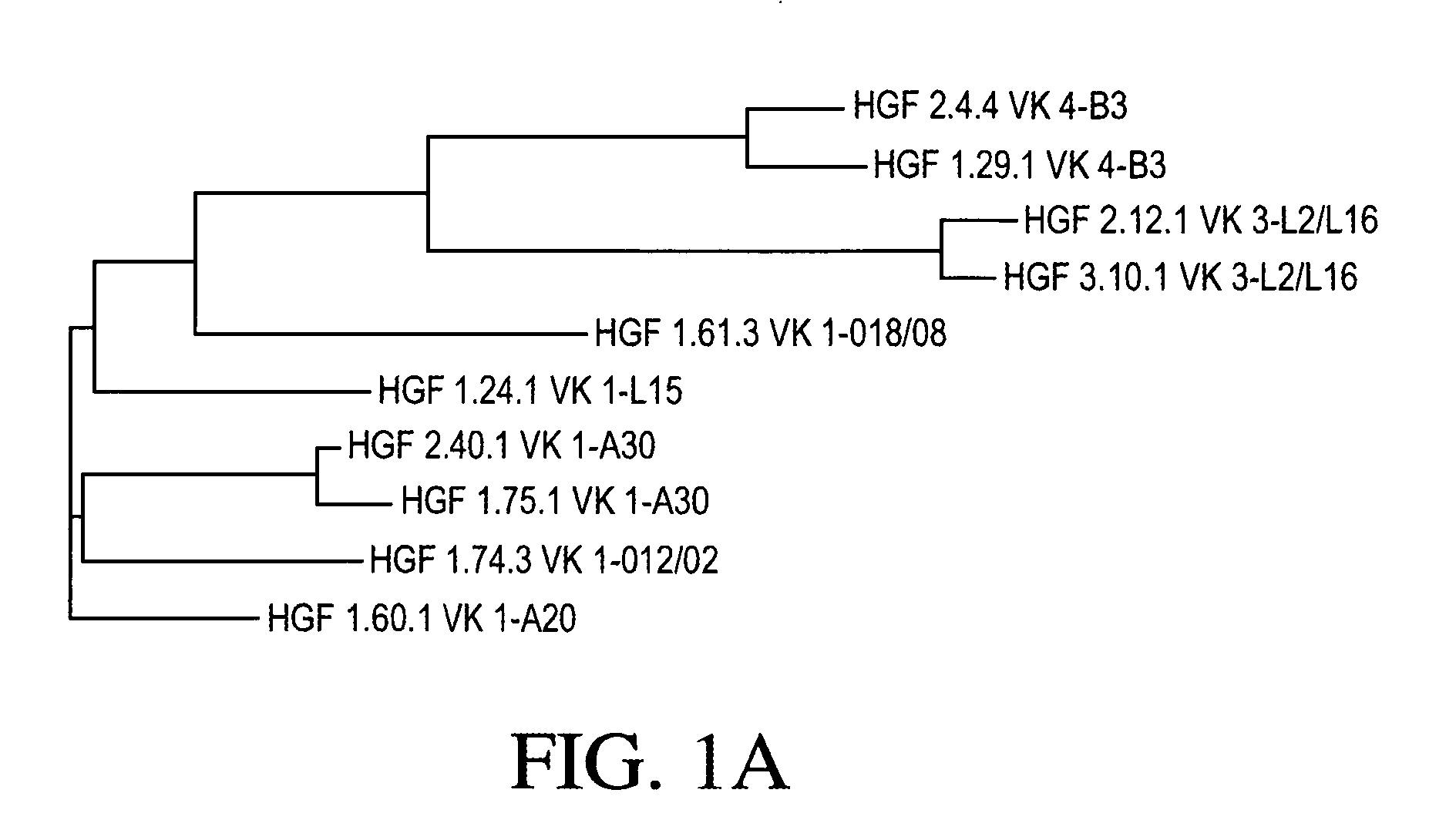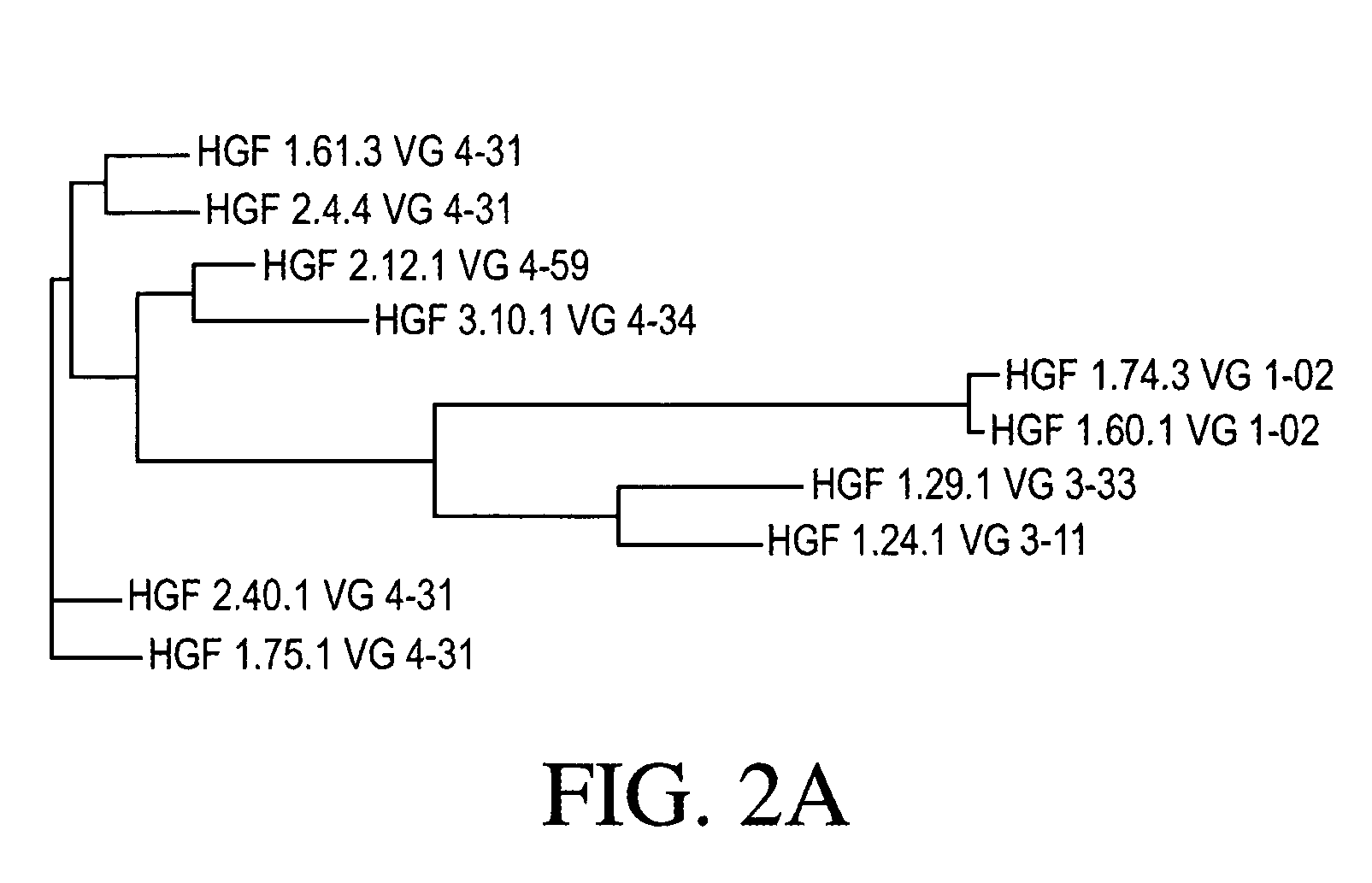Specific binding agents to hepatocyte growth factor
a technology of hepatocyte growth factor and specific binding agent, which is applied in the field of specific binding agent, can solve the problems of tumors and excess number of cells, and achieve the effect of decreasing or preventing binding of a specific binding agen
- Summary
- Abstract
- Description
- Claims
- Application Information
AI Technical Summary
Benefits of technology
Problems solved by technology
Method used
Image
Examples
example 1
Generation of Anti-HGF Hybridomas
[0250] Antibodies to HGF were raised in XenoMouse® mice (Abgenix, Fremont, Calif.), which are mice containing human immunoglobulin genes. Three groups of XenoMouse® mice, groups 1a, 1b, and 2, were used to produce antibodies to HGF and are summarized in Table 1. Group 1a consisted of mice of the XenoMouse® strain XMG2, which produces fully human IgG2κ, antibodies. Group 1a mice were immunized with HGF. HGF was prepared using standard recombinant techniques using the sequence in Nakamura et al., Nature 342: 440-443 (1989).
[0251] Group 1b also consisted of mice of the XenoMouse® strain XMG2, but Group 1b mice were immunized with HGF that had been chemically conjugated to a T-cell epitope (TCE) having the sequence: Gln Tyr Ile Lys Ala Asn Ser Lys Phe Ile Gly lie Thr Glu Leu Lys Lys Cys (SEQ ID NO. 47). The TCE was conjugated to HGF by cross-linking through the C-terminal cysteine of TCE to the N-terminus of HGF using Sulpho-SMCC (Pierce, cat# 22322) ...
example 2
Production of Antibodies from the Hybridomas
[0259] Antibodies were prepared from the ten hybridomas discussed in Example 1 using one of two different systems: Integra flasks and sparged spinners.
Integra Flasks
[0260] Seven hybridoma lines, 2.12.1, 1.24.2, 1.29.1, 1.74.1, 1.75.1, 1.60.2, and 2.40.1, were each separately grown in T75 flasks in 20 ml of HSFM media (see Table 2 for media components). When the hybridomas were nearly confluent in the T75 flasks, they were transferred to Integra flasks (Integra Biosciences, Integra CL1000, cat# 90 005).
[0261] The Integra flask is a cell culture flask that is divided by a membrane into two chambers, a small chamber and a large chamber. A volume of 20-30 ml Hybridoma cells at a minimum cell density of 1×106 cells per ml from each of the seven hybridoma lines were placed into the small chamber of seven Integra flasks in Integra media (see Table 2 for components of Integra media). Integra media alone (1 L) was placed in the large chambers...
example 3
Cloning and Sequence Analysis of Antibody Heavy and Light Chains
A. Cloning of Light Chains
[0271] Ten hybridomas (1.24.1, 1.29.1, 1.60.1, 1.61.3, 1.74.3, 1.75.1, 2.4.4, 2.12.1, 2.40.1, and 3.10.1) were identified as expressing monoclonal antibodies to HGF, as discussed in Example 1. Total RNA was isolated from each of those ten hybridomas using TRIzol® reagent (Invitrogen, Carlsbad, Calif.). The 5′-ends of those ten total RNA preparations were adapted for 5′ Rapid Amplification of cDNA Ends (RACE) using the GeneRacer® Kit (Invitrogen). Those ten 5′-modified RNA preparations were then used in ten separate RACE reactions, each using a random primer with an extension adapter (5′-GGC CGG ATA GGC CTC CAN NNN NNT-3′) (SEQ ID NO: 48), to generate ten cDNA molecules.
[0272] The ten cDNA molecules were then amplified in separate polymerase chain reactions (PCR) to generate ten amplified kappa light chain sequences. For each of those reactions, the forward primer was the forward GeneRacer™...
PUM
| Property | Measurement | Unit |
|---|---|---|
| Fraction | aaaaa | aaaaa |
| Fraction | aaaaa | aaaaa |
| Fraction | aaaaa | aaaaa |
Abstract
Description
Claims
Application Information
 Login to View More
Login to View More - R&D
- Intellectual Property
- Life Sciences
- Materials
- Tech Scout
- Unparalleled Data Quality
- Higher Quality Content
- 60% Fewer Hallucinations
Browse by: Latest US Patents, China's latest patents, Technical Efficacy Thesaurus, Application Domain, Technology Topic, Popular Technical Reports.
© 2025 PatSnap. All rights reserved.Legal|Privacy policy|Modern Slavery Act Transparency Statement|Sitemap|About US| Contact US: help@patsnap.com



